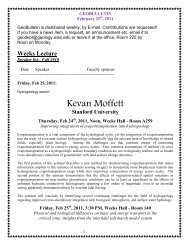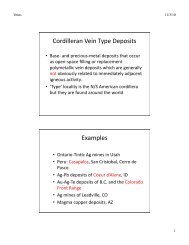Electron microprobe dating of monazite
Electron microprobe dating of monazite
Electron microprobe dating of monazite
You also want an ePaper? Increase the reach of your titles
YUMPU automatically turns print PDFs into web optimized ePapers that Google loves.
48 .I.-M. Montel et al./ Chemical Geology 131 (1996) 37-53<br />
limits <strong>of</strong> the method, as discussed above; (2) samples<br />
<strong>of</strong> known age in order to definitively demonstrate its<br />
reliability. The comparison between the 'micro-<br />
chemical ages' and 'isotopic ages' obtained by other<br />
methods, is presented in Fig. 4. The agreement is<br />
excellent, always within the limits <strong>of</strong> analytical error.<br />
Frequently in polycyclic rocks we found multiple<br />
ages. In many cases, these ages correspond to previ-<br />
ously recognized events in the same area (for exam-<br />
ple the micro-chemical age corresponds to the U-Pb<br />
zircon age, while another <strong>monazite</strong> population yields<br />
a younger age identical to the Rb/Sr biotite age on<br />
the same rock). The appearance <strong>of</strong> a previously<br />
unknown age was very rare. It can be an age older<br />
than any known age, which we consider to trace an<br />
old component, or an age younger than any other<br />
one, which we interpret as evidence for a younger<br />
event having reset some crystals. Finally. it can be<br />
an age intermediate between two well-documented<br />
ages, more difficult to interpret because it might be a<br />
meaningless age, resulting from lead diffusion<br />
(Suzuki et al., 1994).<br />
5.2. Limits<br />
The main limit <strong>of</strong> this method is the absence <strong>of</strong><br />
<strong>monazite</strong>. Although relatively common, <strong>monazite</strong> is<br />
not as widely distributed as zircon or biotite which<br />
are used in other methods. Ca-rich rocks such as<br />
mafic and intermediate rocks <strong>of</strong> any type do not<br />
3.C<br />
2.5<br />
0<br />
"E 2.0<br />
c-<br />
O 1.5<br />
0<br />
"E 1.0<br />
O.E<br />
Ga ./<br />
¢/ //<br />
./<br />
contain <strong>monazite</strong>, neither do metabasite or marie<br />
greywackes (Cuney and Friedrich, 1987; Lee and<br />
Dodge, 1964). Low-grade metamorphic rocks also<br />
seem poor in <strong>monazite</strong> (Kingsbury et al., 1993). The<br />
lower limit to ages is at present about 100 Ma, but it<br />
is probably possible to lower this limit with another<br />
<strong>microprobe</strong>, in particular by using a higher probe<br />
current. Finally, this method is one order <strong>of</strong> magni-<br />
tude less precise than isotopic methods.<br />
5.3. Adcantages<br />
The advantages <strong>of</strong> this method were discussed<br />
above, but can be summarized as follows:<br />
(1) It is accessible to many geologists because<br />
electron probes are widespread in earth sciences<br />
departments, and familiar to all petrologists.<br />
(2) It is faster than conventional isotopic <strong>dating</strong>.<br />
When only <strong>dating</strong> is needed, work can be done either<br />
tm mineral separates or on thin-sections. In the latter<br />
case the identification and <strong>dating</strong> <strong>of</strong> <strong>monazite</strong>s can<br />
be done during the same session. Acquisition <strong>of</strong><br />
20 × 100 s measurements, with the complete statisti-<br />
cal and age calculation procedure, is carried out in<br />
Clermont-Ferrand in less than 2 h. More detailed<br />
work is time-consuming, but even the most complex<br />
sample does not require more than 4 h <strong>of</strong> micro-<br />
probe, 1 h <strong>of</strong> SEM, and 1 h <strong>of</strong> optical microscope<br />
work.<br />
(3) It is non-destructive. This means that it is<br />
possible to re-analyse crystals when necessary, to<br />
1<br />
/ 600<br />
/ 500<br />
* /<br />
-- 40o<br />
3OO<br />
2OO<br />
- - _ --_J/<br />
fir 1 oo<br />
I<br />
I<br />
0.5 1.0 ~.s 2.0 2.5 3.0<br />
isotopic age<br />
/<br />
/ Ma<br />
/<br />
7.<br />
100 200 300 400 500 600 700<br />
Fig. 4. Comparison between ages obtained with the electron probe ('micro-chemical age') and by conventional isotopic methods ('isotopic<br />
age').





